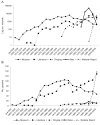Distorted views of biodiversity: spatial and temporal bias in species occurrence data
- PMID: 20532234
- PMCID: PMC2879389
- DOI: 10.1371/journal.pbio.1000385
Distorted views of biodiversity: spatial and temporal bias in species occurrence data
Abstract
Boakes et al. compile and analyze a historical dataset of 170,000 bird sightings over two centuries and show how changing trends in data gathering may confound a true picture of biodiversity change.
Conflict of interest statement
The authors have declared that no competing interests exist.
Figures








References
-
- UNEP (United Nations Environment Programme) Nairobi: UNEP; 2002. Report on the sixth meeting of the Conference of the Parties to the Convention on Biological Diversity (UNEP/CBD/COP/20/Part 2) Strategic Plan Decision VI/26 in CBD.
-
- Balmford A, Bennun L, ten Brink B, Cooper D, Cote I. M, et al. The convention on biological diversity's 2010 target. Science. 2005;307:212–213. - PubMed
-
- Collen B, Loh J, Whitmee S, McRae L, Amin R, et al. Monitoring Change in Vertebrate Abundance: the Living Planet Index. Conserv Biol. 2009;23:317–327. - PubMed
-
- Sheppard C. The Shifting Baseline Syndrome. Mar Pollut Bull. 1995;30:766–767.
Publication types
MeSH terms
LinkOut - more resources
Full Text Sources
Other Literature Sources

